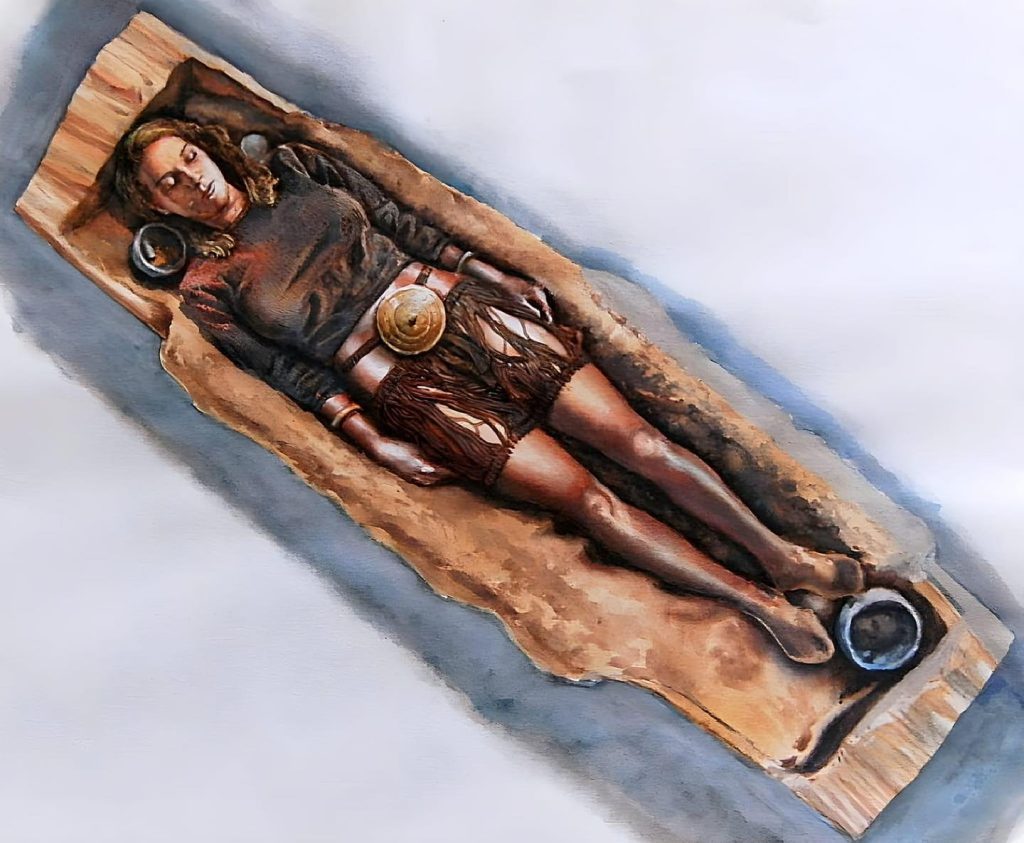In 1921, an extraordinary archaeological discovery in Denmark offered an unparalleled window into life during Bronze Age Europe. Hidden deep within a peat bog near the small town of Egtved lay the well-preserved remains of a teenage girl—now famously known as the Egtved Girl. Her story, dating back over 3,400 years, continues to captivate archaeologists, historians, and anyone with a passion for understanding the distant past. Through the miracle of preservation and the power of modern scientific analysis, the Egtved Girl’s life and legacy provide a profound glimpse into a world that was far more interconnected and complex than previously imagined.

The circumstances of her discovery were remarkable in their own right. Buried within an oak coffin, the Egtved Girl’s body had been naturally preserved by the unique chemistry of the peat bog. Although her bones had mostly decayed over millennia, her hair, fingernails, and clothing were astonishingly intact. This level of preservation is rare and offered researchers an invaluable opportunity to examine Bronze Age clothing, personal grooming, and burial customs in unprecedented detail. Her hair was carefully arranged, her fingernails well-manicured, and her attire both functional and symbolic, giving scholars critical insight into the daily life and cultural values of her time.
The greatest surprise, however, came nearly a century after her discovery. In 2015, isotopic analysis of her hair, teeth, and nails revealed a startling truth: the Egtved Girl was not originally from Denmark. Instead, scientific evidence pointed to the Black Forest region in southern Germany as her homeland. This revelation transformed the narrative around her life, suggesting that she traveled great distances during her short lifetime—an extraordinary feat in an era long before modern transportation. Her journey from the heart of Europe to the northern reaches of Denmark reflects a level of mobility and cultural exchange previously unrecognized in Bronze Age studies.
Her clothing further underscores the sophistication of her time. She was dressed in a woolen skirt, skillfully woven and dyed, paired with a bronze belt disc adorned with intricate spiral motifs. These designs are believed to be tied to sun worship, a widespread religious practice among Bronze Age societies in northern Europe. The craftsmanship of her attire—and the fact that the wool was traced back to southern Germany—speaks to extensive trade routes and cultural ties that linked distant regions. The Egtved Girl’s wardrobe was not merely functional; it was also a symbol of her status and possibly her role within a religious or political framework.
The question of her identity remains one of the most compelling aspects of her story. Two prevailing theories dominate scholarly debate. One possibility is that she was a priestess in a sun cult, part of a broader religious tradition that celebrated the cycles of the sun and nature. Her burial items and the symbolic patterns on her belt disc support this notion. The second possibility is equally intriguing: she may have been involved in a diplomatic marriage, uniting powerful families from different regions in an effort to strengthen political alliances. In either case, her presence in Denmark suggests that women in the Bronze Age could hold positions of significant influence, both spiritually and politically.
The Egtved Girl’s life challenges many long-held assumptions about Bronze Age Europe. Her journey from southern Germany to Denmark demonstrates that people, goods, and ideas moved across vast distances, connecting disparate regions in ways that mirror the complexities of modern globalization. Her burial site, carefully prepared and richly adorned, is a testament to the value placed on her life and role in society. Far from being isolated or primitive, Bronze Age communities engaged in sophisticated religious practices, maintained long-distance trade networks, and forged political alliances across great distances.
What can we learn from her story? First, it highlights the widespread nature of religious traditions in ancient Europe, with shared symbols and beliefs linking communities from Germany to Scandinavia. Second, it illustrates the vital role women played in these societies—not only in domestic spheres but also in matters of religion and politics. Third, it offers tangible proof of advanced craftsmanship and the far-reaching trade systems that supported cultural exchange throughout the continent.
The Egtved Girl stands as a powerful symbol of a world that was both ancient and surprisingly modern. Her preserved remains serve as a bridge through time, connecting us to an era when Europe was already a web of interactions, beliefs, and alliances. Her legacy lives on, not only in museum exhibits and academic journals but also in the ongoing curiosity and admiration she inspires. Each discovery tied to her life enriches our understanding of human history and deepens our appreciation for the resilience and creativity of past civilizations.
As we continue to explore and study the artifacts left behind by the people of the Bronze Age, the Egtved Girl remains one of the most compelling figures from that time. Her story is a testament to the enduring power of archaeological discovery and a reminder that, even thousands of years ago, human beings were connected in ways that continue to shape our world today. Through her, we glimpse not only the past but also the timeless human quest for meaning, connection, and legacy.





